This weekend I met with Gjon Feinstein and Eric Montany and showed them some of my games from my most recent tournament, the U.S. Amateur Team West championship. One of my games was weird. The good news is that I beat a 2300 player, Steven Jacobi. Because I didn’t beat a single player rated over 2200 all last year, it was nice to find out that I could still do it. But on the other hand, I couldn’t put my finger on any particular thing that I did right. It seemed to me as if my opponent just beat himself.
Nevertheless, both Gjon and Eric said that they were very impressed with the game, so there must be something good about it. Let’s see.
Steven Jacobi – Dana Mackenzie
English Opening
1. c4 g6
I recently decided that this was the psychologically correct way to play against 1. c4. You’ll see why in a second.
2. g3 Bg7 3. Bg2 e5
Here’s why I like this move order. I get to play … e5 without committing either knight to f6 or c6, and also White’s d2-d4 break is discouraged. Of course White could have prevented this by playing 2. d4, but that is psychologically impossible for an English player. If they liked those positions they would have played 1. d4 on the first move.
4. Nc3 Ne7 5. d3 O-O 6. Rb1 a5 7. a3 h6 8. f4?! ef 9. Bxf4 g5 10. Bd2 …
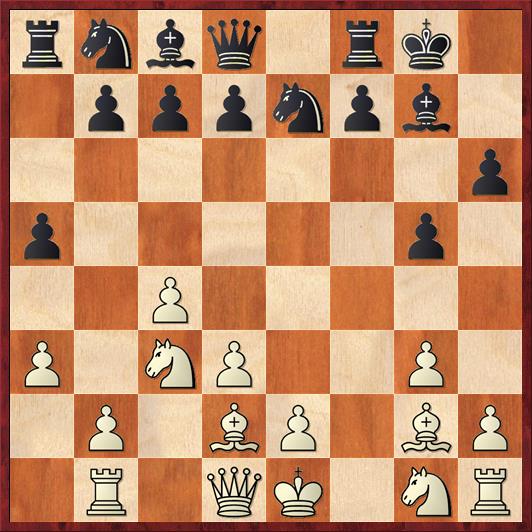 Position after 10. Bd2. Black to move.
Position after 10. Bd2. Black to move.
FEN: rnbq1rk1/1pppnpb1/7p/p5p1/2P5/P1NP2P1/1P1BP1BP/1R1QK1NR b K – 0 10
Now I get to play the defining move of this variation.
10. … Ra6!
Curiously, I also played this rook lift in my first game with the 1. … g6 move order. That was Rand-Mackenzie, from January 2015: 1. c4 g6 2. g3 Bg7 3. Bg2 e5 4. Nc3 Ne7 5. d3 O-O 6. e3 a5 7. Nge2 f5 8. O-O Ra6 (diagram).
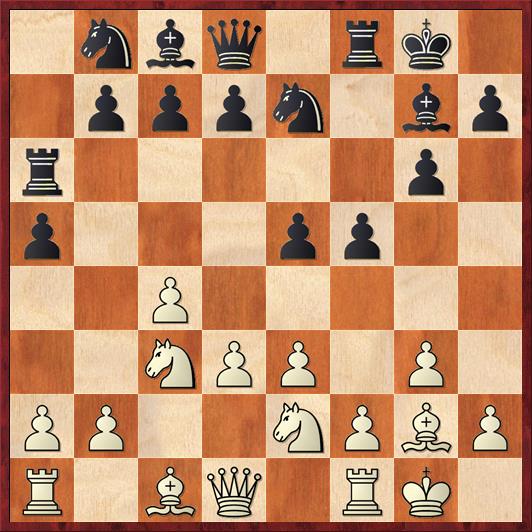 Position after 8. … Ra6 (Rand-Mackenzie). White to move.
Position after 8. … Ra6 (Rand-Mackenzie). White to move.
FEN: 1nbq1rk1/1pppn1bp/r5p1/p3pp2/2P5/2NPP1P1/PP2NPBP/R1BQ1RK1 w – – 0 9
In Rand-Mackenzie the rook lift was a spur-of-the-moment improvisation. White played 9. d4 and I decided that I needed to shore up the center with 9. … d6. This left the rook a bit oddly placed, but it turned out to play an important role later, steadying my queenside and eventually invading on a2. I won the game. After that game I felt that if the g6 square had already been available for my rook, I would have been very happy playing 9. … Rg6. When Jacobi gave me the chance to play … g5, and even gain a tempo with it (hitting his bishop), I was primed and ready for the rook lift.
Now back to the main game.
11. Nf3?! …
I think that this is just too routine. White should play something more active like 10. e4 or 10. Nd5 to discourage Black’s idea.
11. … d5
Both Gjon and Eric sort of sucked in their breath here, as if to say “Oh-oh, watch out.” I agree, it’s a somewhat loosening move, but I felt that White’s play was too slow and “open lines go to the better developed player.” Note, by the way, that Black’s bishop on c8 is developed. Because it no longer poses an obstacle to Black’s queen rook, the bishop can happily stay on c8 until it’s needed somewhere else.
12. cd Nxd5 13. O-O Ne7 14. Kh1?! …
Really? White’s play in this opening just seems completely lazy to me. The only un-lazy move was 8. f4, but that was not so good either! Eric put it best: “It feels as if he’s just playing on his side of the board and not even paying attention to what’s happening on your side of the board.” Again, I attribute it to psychology. English Opening players like this “system” approach. But he lets me get away with something completely absurd, a rook fianchetto.
14. … Rg6!
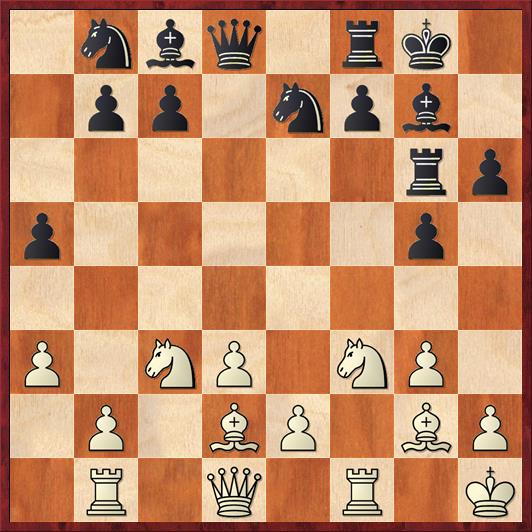 Position after 14. … Rg6. White to play.
Position after 14. … Rg6. White to play.
FEN: 1nbq1rk1/1pp1npb1/6rp/p5p1/8/P1NP1NP1/1P1BP1BP/1R1Q1R1K w – – 0 15
Maneuver complete! My rook on g6 is as happy as a clam. It cannot be harassed by White pieces, and it just feels as if I’m a piece up on the kingside. And the queenside is solid enough that I don’t think the rook’s absence will be felt there. It’s amazing how quickly White gets into serious trouble.
15. Ne4 Nc6 16. Bc3 Nd5!
Back comes the knight with a vengeance.
17. Bxg7 Kxg7
Eric was disappointed that I didn’t take with the rook, completing the rook fianchetto, but I think that … Rg6 already counted as a rook fianchetto.
18. Qd2 Re8
White can’t do anything about the threat of … f5 and … Ne3. He tries to complicate things tactically, but remember what I said about open lines and better development?
19. b4 f5 20. Qb2+ Kh7 21. b5 fe
No time to chicken out now.
22. de …
If 22. bc ef 23. Rxf3 (23. cb? is a disaster for White because 23. … fg+ comes with check) 23. … bc 24. Rf7+ Kg8 25. R1f1 Be6 and White’s a piece down for no compensation.
22. … Ne3
It’s getting spicy! Time for a diagram.
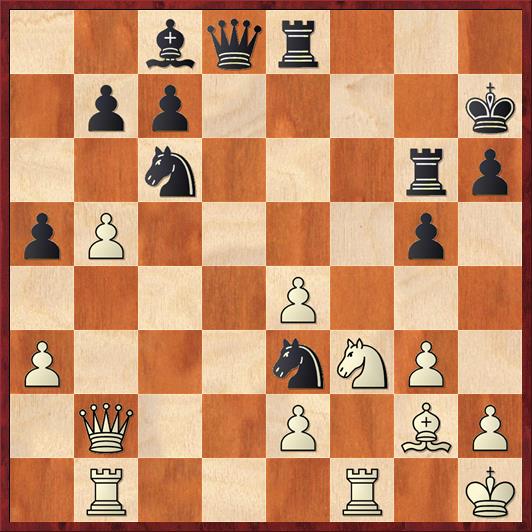 Position after 22. … Ne3. White to move.
Position after 22. … Ne3. White to move.
FEN: 2bqr3/1pp4k/2n3rp/pP4p1/4P3/P3nNP1/1Q2P1BP/1R3R1K w – – 0 23
23. bc …
If White had played 23. Rf2 I could probably get away with 23. … Ne7, just remaining a piece up. But it’s more likely that I would have gone for the gut punch 23. … Nd1! This sort of move can’t be planned ahead — it just happens when your pieces are active and coordinating well.
23. … Nxf1 24. Rxf1
The alternative 24. cb Bxb7 25. Qxb7 Ne3 offers White nothing. With the text move White is still trying to invade on the f-file and whip up a kingside attack. But Black’s “extra rook” on g6 makes it feel as if White is banging his head against a brick wall. There are just too many Black pieces around for the attack to get anywhere.
24. … b6
I had no interest in creating pawn weaknesses by taking on c6. I can pick that pawn up later.
25. e5 Qe7
We now get an amusing sequence where White makes six consecutive queen moves (trying to probe for a weakness) and then self-traps his queen.
26. Qb3 Rf8 27. Qd3 Bf5 28. Qd4 Rd8 29. Qc4 Be6 30. Qe4 Bd5 31. Qf5 Kg7 32. e4??
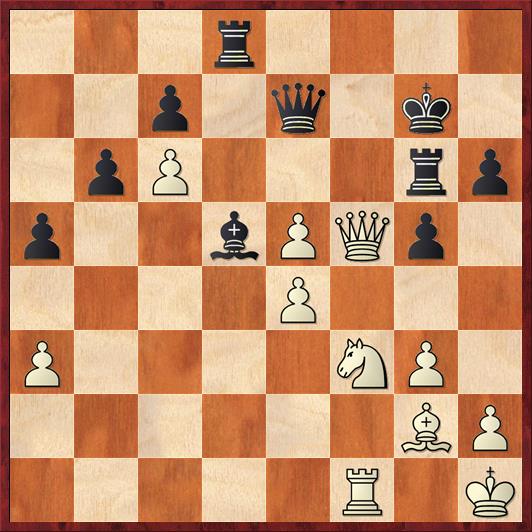 Position after 32. e4. Black to move.
Position after 32. e4. Black to move.
FEN: 3r4/2p1q1k1/1pP3rp/p2bPQp1/4P3/P4NP1/6BP/5R1K b – – 0 32
How, you might ask, could a 2300 player play such a move? Well, he’s an exchange down, he can’t find any way to create serious threats, and to make matters worse his clock is down to about one minute to make eight more moves until the time control. Even though there is a five-second delay, that is still some serious time pressure. I think he was probably expecting 32. … Bxc6 and didn’t even think about the other move.
32. … Be6! 33. Nh4 …
This saves the queen but loses a piece.
33. … gh 34. Qf4 hg 0-1
Here White’s flag fell, which must have come as a relief to him because he’s a rook down and his position is crumbling.
Ironically, the fianchettoed rook never made another move after its long-distance journey from a8 to a6 to g6. Nevertheless, I feel as if it had a huge impact on the game. Aside from that, it seemed as if I didn’t do anything special. My pieces just all ended up in the right places, and then my opponent lashed out and sacrificed material but my position was just as solid as a rock.
I felt bad for my opponent because I’m sure he is a much better player than he showed in this game. This is what they call an “agony game,” one that the loser would just rather forget. I’ve had plenty of that kind too, so I’m glad to be on the winning side for a change.
Addendum: The first version of this post (posted 15 minutes ago) had a missing move pair. I hope that this didn’t confuse anyone.


